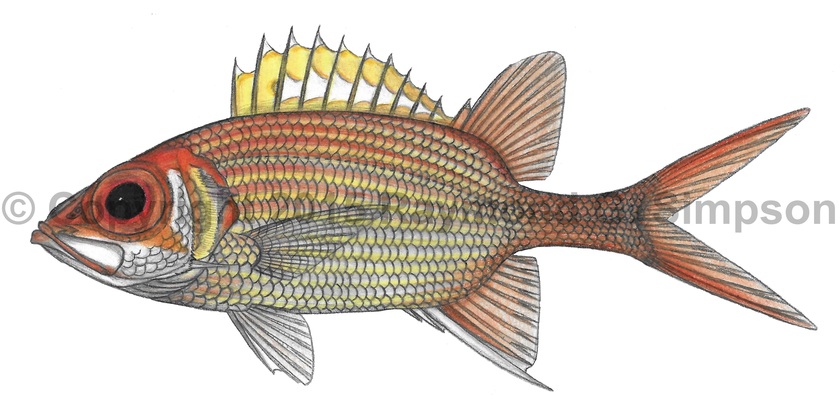
Common Name
Longjaw squirrelfish
Year Described
Cuvier, 1829
Identification
Dorsal Fin: XI, 12-13
Anal Fin: IV, 8-9
Pectoral Fin: 14
Lateral Line Scales: 45-48
Vertebrae: 27 (total)
Gill Rakers: 10-14
Body oval with a flattened ventrum and convex dorsal profile. Head with small spines on suborbital. Snout long and pointed with a convex frontal profile. Eye large. Preopercle with a large, strong spine at the angle. Opercle with 2 strong spines and additional serrations on margin. Mouth large; reaching middle of orbit but on a longer snout. Lower jaw strongly projecting. Dorsal fins almost separate with strong notch. Rear dorsal, anal, and caudal fins pointed. Last dorsal spine longer than second to last spine. Last spine bunched with dorsal rays and separate from rest of spines by notch. Third anal spine long and strong. Scales obvious.
Color
Body and head bright pinkish-red with several parallel yellow stripes following scale rows. Lower head and preopercle bright silvery. Opercle bright yellow. Eye bright red. Spiny dorsal fin bright yellow with white tips and a line of white triangles in the median area. Soft dorsal and caudal fin pale pink with darker rays and red anterior margin. Anal fin pink with a white anterior margin. Rest of fins pale pink.
Size
Maximum size to 22cm SL
Habitat
Inhabits coral reefs from the surface to 120m.
Range
Florida Keys and the Gulf of Mexico, and the entire Caribbean Sea.
References
Dornburg, A., J. A. Moore, R. Webster, D. L. Warren, M. C. Brandley, T. L. Iglesias, P. C. Wainwright, and T. J. Near. 2012. Molecular phylogenetics of squirrelfishes and soldierfishes (Teleostei: Beryciformes: Holocentridae): reconciling more than 100 years of taxonomic confusion. Molecular Phylogenetics & Evolution. 65: 727–738.
McEachran, J.D. and J.D. Fechhelm. 1998. Fishes of the Gulf of Mexico. Volume 1: Myxiniformes to Gasterosteiformes. University of Texas Press, Austin. i-viii + 1-1112.
Other Notes
Phylogenetic evidence places this species outside the clade of Neoniphon and suggests the resurrection of the genus Flammeo for this Atlantic species (Dornburg et al., 2012).